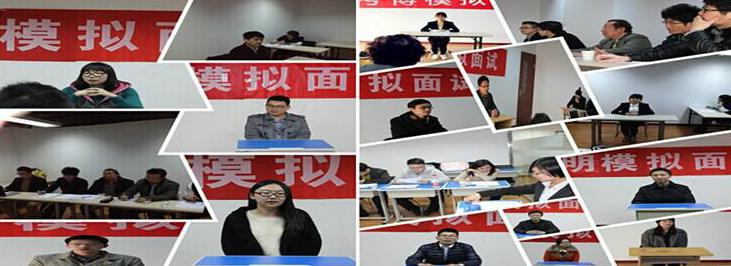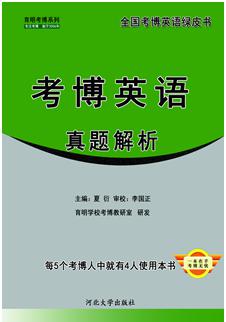资料来源:《考博英语真题解析》育明教育出品,北外夏衍教授主编
更多考博资讯、资料获取、考博课程QQ:547063862 电话:153-1148-1034
针对北京地区院校的考博开设的辅导课程包括:专业课小班课程·一对一课程·视频班·定向保录班·复试保过班。根植育明学校深厚的高校资源,整合利用历届育明优秀学员的成功经验与高分资料,为每一位学员构建考博成功的基础保障,辅导学员人数及辅导成绩连续多年稳居第一。



Part III: Reading Comprehension
Passage 1
The Carnegie Foundation report says that many colleges have tried to be “all things to all people”. In doing so, they have increasingly catered to a narrow-minded careerism while failing to cultivate a global vision among their students. The current crisis, it contends, does not derive from a legitimate desire to put learning to productive ends. The problem is that in too many academic fields, the work has no context; skills, rather than being means, have become ends. Students are offered a variety of options and allowed to pick their way to a degree. In short, driven by careerism, “the nation’s colleges and universities are more successful in providing credentials than in providing a quality education for their students. “The report concludes that the special challenge confronting the undergraduate college is one of shaping an integrated core of common learning. Such a core would introduce students to essential knowledge, to connections across the disciplines, and in the end, to application of knowledge to life beyond the campus."
Although the key to a good college is a high-quality faculty, the Carnegie study found that most colleges do very little to encourage good teaching. In fact, they do much to undermine it. As one professor observed: “Teaching is important, we are told, and yet faculty know that research and publication matter most.” Not surprisingly, over the last twenty years colleges and universities have failed to graduate half of their four-year degree candidates. Faculty members who dedicated themselves to teaching soon discover that they will not be granted tenure, promotion, or substantial salary increases. Yet 70 percent of all faculties say their interests lie more in teaching than in research. Additionally, a frequent complaint among young scholars is that “There is pressure to publish, although there is virtually no interest among administrators or colleagues in the content of the publications.”
51. When a college tries to be “all things to all people” (Para. 1), it aims to ________.
A. satisfy the needs of all kinds of students simultaneously
B. focus on training students in various skills
C. encourage students to take as many courses as possible
D. make learning serve academic rather than productive ends
52. By saying that “in too many academic fields, the work has no context” (Para.1), the author means that the teaching in these areas ________.
A. ignores the actual situation
B. is not based on the right perspective
C. only focuses on an integrated core of common learning
D. gives priority to the cultivation of a global vision among students
53. One of the reasons for the current crisis in American colleges and universities is that ________.
A. a narrow vocationalism has come to dominate many colleges
B. students don’t have enough freedom in choosing what they want to learn
C. skills are being taught as a means to an end
D. students are only interested in obtaining credentials
54. American colleges and universities failed to graduate half of their four-year degree candidates because ________.
A. most of them lack high-quality faculties
B. the interests of most faculty members lie in research
C. there are not enough incentives for students to study hard
D. they attach greater importance to research and publication than to teaching
55. It can be inferred from the passage that high-quality college education calls for ________.
A. putting academic work in the proper context
B. a commitment to students and effective teaching
C. the practice of putting leaning to productive ends
D. dedication to research in frontier areas of knowledge
Passage 2
Endangered Species
Endangered species are plants and animals that are in immediate danger of extinction. Extinction is actually a normal process in the course of evolution. Since the formation of the earth, many more species have become extinct than those exist today. These species slowly disappeared because of changes of climate and their failure to adapt to such conditions as competition and predation. Since the 1600s, however, the process of extinction has greatly accelerated as a result of both human population growth and technological encroachment on natural ecology systems. Today the majority of the world’s environments are changing faster than the ability of most species to adapt to such changes through natural selection.
Species become extinct or endangered for a number of reasons, but the primary cause is the destruction of natural habitats. Drainage of wetlands, cutting and clearing of forests, growth of cities, and highway and dam construction have seriously reduced available natural habitats. As the various surroundings become fragments, the remaining animal populations crowd into smaller areas, causing further destruction of natural surroundings. Species in these small islands” lose contact with other populations of their own kind, thus reducing their genetic variation and making them less adaptable to environment changes.
Since the 1600s, commercial exploitation of animals for food and other products has caused many species to become extinct or endangered. Introduced diseases and parasites have also greatly reduced some species. Pollution is another important cause of their extinction.
Some private and governmental efforts have been organized to save declining species.
Laws were made in some countries in the early 1900s to protect wild animals from commercial trade and killing. International endeavors are shown in the Convention on International Trade in Endangered Species approved by 51 nations. Its purpose is to restrict exploitation of wild animals and plants by regulating and restricting trade in certain species. How effective such laws will be in various countries, however, depends on enforcement and support by the people and the courts. Because of a lack of law enforcement, the willingness of some segments of society to trade in endangered species, the activities of people who catch and kill animals illegally and dealers who supply the trade, the future of many species is in doubt in spite of legal protection.
56. According to the passage, which of the following is the most important factor causing the rapid extinction of main species since the 17th century?
A. Human beings are not aware of the importance of preserving endangered species.
B. Some endangered species have already reached the end of their life span in evolution.
C. The development of human society has greatly affected natural ecology systems.
D. The world’s climate has changed so greatly that most species cannot survive.
57. In the last sentence of the second paragraph, the word islands refers to ________.
A. the lands that are completely surrounded by water
B. the wild animals’ breeding grounds protected by law
C. the pieces of land separated by modern buildings and roads
D. the small and isolated areas inhabited by certain species
58. This passage mentions all of the following reasons that cause the extinction of man species except ________.
A. natural selection of species
B. various natural disasters
C. commercial trade and killing
D. destruction of natural surroundings
59. According to the passage, which of the following is most important in saving declining species?
A. Governments should make some laws to protect endangered species.
B. People should pay more attention to the protection of natural surroundings.
C. Relevant laws must be made and enforced with the support of the people.
D. Some organizations should warn people not to trade in endangered animals.
60. How does the author feel about the prospect of protecting endangered species from being extinct?
A | worried | B | optimistic | C | indifferent | D | confident |
参考答案
51. 选B。从In doing so, they have increasingly catered to a narrow minded careerism一句不难看出大学实现all things to all people的具体表现为狭隘地迎合职业主义,而从后文可推断出学校以技能教育为最终目的,因此最合适答案为B。A项纯属字面意思理解;C项说法本身错误;D项serve academic ends说法不正确。
52. 选A。context本身有“语境”之意,且第一段最后一句话暗示大学应当解决的最核心问题最终是将学到的知识运用于实践,实践实际就是指“实际状况”,因此A项最符合,B项文中未提及,C、D两项均与文中意思违背。
53. 选C。The current crisis, it contends, does not derive from a legitimate desire to put learning to productive ends….. skills, rather than being means, have become ends这一小段直接解释了美国大学现阶段问题的主要原因,即把技能当作教学的最终目的。A是问题的一种表现;B文中未提及;D说法错误,应当是学校方面对文凭过于重视,而非学生自身对其感兴趣。
54. 选D。从第二段开头几句不难看出,大多数学校对于教学质量并不重视,而更加偏重科研和论文发表。A、B、C三项说法均不符合文意,故排除。
55. 选B。本文两段分别提出并论述了“学生素质教育”和“忽视教学,过分注重科研”两个问题,因此只有B项概括了这两个方面。